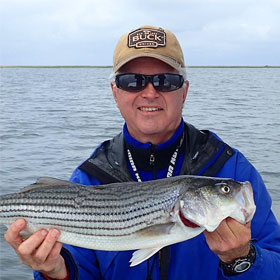A Primer on Recreational Crabbing and Crab Fishing License Needs
By Ken Schultz
Dec 12, 2018
Here’s info about whether you need a crab fishing license, where you can crab, the species, size, and number you can catch, the season, and other considerations.
Until I moved to a coastal area the whole notion of recreational crabbing and whether or not I needed a crab fishing license was a foreign concept. But I soon found out that hand-lining for these crustaceans was fun for a lot of people, and now know why I often see people with crab lines and dip nets standing at coastal docks, piers, and bridges, some of them locals and some of them visitors.
My elderly mother-in-law and my young grandchildren were equally fond of sitting on a dock and hauling in a crab that latched onto their baited lines. The only difference was that my mother-in-law enjoyed eating the crabs, and the kids didn’t. Neither needed a crab fishing license or a saltwater fishing license to do this in Virginia, where I live.
Actually, most of my crabs are caught in pots and Virginia allows anyone to have two crab pots per person for recreational use without having to obtain a special fishing license. In some states, you’re covered for certain crabbing activities by your saltwater recreational fishing license. Whether you need a separate crab fishing license or not depends on the laws in your state and on the species and method of crabbing you employ.
I encourage you to go to the website for the state agency where you will be crabbing, and look for its recreational crab fishing regulations. That said, here are a few things to keep in mind.
Which crab?
Be attentive to regulations by species. It’s all about blue crabs where I live, but in California there are Dungeness crabs and several species of rock crab. Regulations and seasons are different depending on the species. Regulations may also differ with respect to hard crabs, soft crabs (which have just molted), and peelers (which are about to molt).
Where can you crab?
Generally, crab fishing regulations apply to all tidal waters, but there may be some locations where a state agency prohibits crabbing (like a designated sanctuary) or advises against it (perhaps for water quality reasons).
How are you crabbing?
Rules may differ depending on the gear and method used. Recreational fishing for crabs is done by hand-lining (using a weighted and impaled bait, like fish heads and chicken necks, on a line that is lowered by hand into the water), hand-netting or dip-netting (using a long-handled net to scoop up swimming crabs), and by setting crab pots (which are baited and capture a number of crabs at a time). In some places, divers can harvest crabs by hand.
How many can you keep?
With or without a license, a recreational crabber may only catch crabs for personal use. There will be a daily limit on the number that you can catch. In Virginia, for instance, that’s a bushel of hard crabs and two dozen peelers. In California, it’s ten Dungeness crabs.
What size crabs are allowed?
This will vary by state and species, and perhaps even by season. In some places, crab pots are required to have cull rings that are sized to allow crabs below the legal minimum to escape. If undersized crabs are caught in a pot or by other means, they must be released.
What’s the season?
In some places certain crab species can be caught recreationally year-round. That applies, for example, to rock crabs in California. In others, there’s a season that generally runs from spring into fall, although the specific opening and closing dates may change each year.
Other considerations
You may want to get a recreational crab fishing license if you’d like to use more than a few crab pots at a time. State regulations may require you to mark and/or identify your pots, too. Finally, in some states where blue crabs are caught, recreational crab pots must have a turtle exclusion device (TED) at each entrance. Made from plastic or metal, these rectangular accessories prevent diamondback terrapins from entering, and drowning in, a crab pot. Even if not required, you should put TEDs on crab pots for the sake of the turtles.









